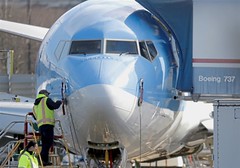
I’ve been thinking about Sunday’s Ethiopian Airlines crash and why the Federal Aviation Administration was the last national regulatory agency to ground Boeing 737 Max aircraft.
I mean, here’s the second fatal 737 Max crash in less than five months, a death toll standing at 346, and evidence emerging that the Ethiopian crash might have resulted from the same sort of uncommanded flight control anomaly that brought down the Lion Air 737 Max off Indonesia last October. That was more than enough to cause nations around the world to ground the plane until Boeing comes out with a fix, but not enough for the FAA … until yesterday, when Trump saw which way the wind was blowing and directed them to do it.
There’s a problem with the FAA not many people outside the industry understand, a problem poorly covered by the media: the conflict created by FAA’s dual role to regulate the aviation and air travel industry while at the same time promoting and encouraging it.
I listen to NPR every morning on our bathroom radio. Lo and behold, this morning NPR brought on Daniel Elwell, the acting administrator of the FAA, to talk about yesterday’s 737 Max grounding. The interviewer brought up the very issue I’ve been thinking about, the FAA’s conflict between regulating and promoting the airline industry. To my astonishment, Elwell declared there is no conflict, that the dual mandate went away 30 years ago after the Valujet crash in Florida, and that the only mission of the FAA today is to ensure air safety.
The NPR interviewer didn’t press him on that statement, but it didn’t sound right to me, so I engaged the cyber. And guess what? It isn’t right. Here’s a mission statement, taken from its own website:
The mission of the FAA is to provide the safest, most efficient aerospace system in the world. The role of the FAA Airports organization in meeting this goal is to provide leadership in planning and developing a safe and efficient national airport system to satisfy the needs of aviation interests of the United States.
And here’s a partial list of the FAA’s major roles and responsibilities, also from faa.gov:
– Regulating civil aviation to promote safety
– Encouraging and developing civil aeronautics, including new aviation technology
“Satisfying the needs of aviation interests” and “encouraging and developing civil aeronautics”? The conflict’s baked in.
Acting Administrator Elwell mentioned the Valujet crash in Florida. The National Transportation Safety Board, or NTSB, is the independent government agency responsible for determining probable causes of transportation accidents and making recommendations to improve safety. But here’s the deal: the NTSB can only make recommendations. It can’t enforce them. That’s up to the FAA, which doesn’t have to (and often doesn’t) implement NTSB recommendations.
Aircraft cargo hold fires have always been a grave danger, sometimes resulting in fatal crashes. Way back in 1988 the NTSB issued a recommendation that airlines install smoke alarms and fire suppression systems in cargo holds. The FAA didn’t act on that recommendation until the Valujet DC-9 crash in 1996 (23 years ago, not 30), when oxygen cannisters improperly stowed in the cargo hold caught fire, bringing the airplane down in the Florida Everglades, killing all 110 people on board. Even then, the FAA gave the airlines until 2001 to retrofit their fleets.
Acting Administrator Elwell is right in that the FAA got a severe spanking over that decision, but the decision stood and the FAA’s charter didn’t in fact change. The conflict is still there, encoded in the FAA’s DNA.
“Regulating civil aviation to promote safety” says ground the 737 Max until Boeing fixes it.
“Satisfying the needs of aviation interests” and “encouraging and developing civil aeronautics” says to consider the impact grounding the 737 Max will have on Boeing and the US airlines that fly the aircraft.
Wikipedia says it another way:
The dual roles of encouraging aerospace travel and regulating aerospace travel are contradictory. For example, to levy a heavy penalty upon an airline for violating an FAA regulation which would impact their ability to continue operating would not be considered encouraging aerospace travel.
The system isn’t broken, necessarily. It’s functioning as designed. There’s nothing evil or wrong with considering the impact regulations will have on the industry being regulated … so long as people aren’t getting killed, that is.
Before you condemn the system, consider that if the NTSB had its way, we’d have to strip naked and endure cavity searches before boarding, then sit in backward-facing seats with webbing holding us firmly in place. Just before takeoff, we’d pull breathing hoses and masks down from the overhead and strap them on as the passenger cabin filled with impact-absorbing foam. If we were lucky, it’d still be warm. Carry-on baggage? Forget it!
Also consider this: air travel is not only the safest form of transportation, it is overwhelmingly so, and getting safer all the time. The FAA, along with the NTSB, plays a major role in ensuring the safety of the flying public.
p.s. If I were running the FAA, I’d ban carry-on baggage effective immediately. Count your lucky stars the only thing I run is this blog!